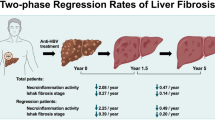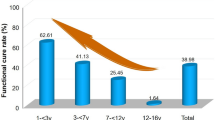Abstract
Background
Nucleot(s)ide analogues (NA) can reduce the risk of hepatocellular carcinoma (HCC), but not completely prevent its development.
Methods
Two hundred and thirty-four chronic hepatitis B patients virologically well controlled with entecavir or tenofovir disoproxil fumarate for more than 1 year were enrolled in this study. Over the median observation period of 51 (12–142) months, 24 of 234 patients developed HCC. We quantified HBV markers, alpha-fetoprotein (AFP) and Mac-2-binding protein glycosylation isomer (M2BPGi) at baseline and 48 weeks after therapy.
Results
Serum AFP and M2BPGi tended to decline from baseline to 48 weeks after treatment both in patients who did and those who did not develop HCC. Univariate Cox regression analysis indicated that serum M2BPGi levels ≥ 1.215 COI at 48 weeks were associated with HCC development [hazard ratio (HR) 5.73; p ≤ 0.001]. Multivariate analysis showed that male sex (HR 5.6; p = 0.01), AFP ≥ 9.65 ng/ml (HR 22.01; p ≤ 0.001), M2BPGi ≥ 1.215 (HR 5.07; p = 0.004) at 48 weeks were significant independent predictive factors for HCC development. Based on a scoring system consisting of three factors above described, Kaplan–Meier analysis for four groups (score 0, 1, 2, ≥ 3), revealed significant differences in cumulative HCC occurrence for each group within 2 years. The rate of incidence of HCC was 0, 5.4, 23.4, and 75% in each group, respectively.
Conclusions
In patients receiving NA therapy, higher M2BPGi at 48 weeks, as well as male sex and higher AFP at 48 weeks were independent risk factors for HCC development.


Similar content being viewed by others
Abbreviations
- HBV:
-
Hepatitis B virus
- HCC:
-
Hepatocellular carcinoma
- NA:
-
Nucleos(t)ide analogues
- CHB:
-
Chronic hepatitis B
- AFP:
-
Alpha-fetoprotein
- ETV:
-
Entecavir
- WFA+-M2BP:
-
Wisteria floribunda agglutinin-positive Mac-2-binding protein
- M2BPGi:
-
Mac-2-binding protein glycosylation isomer
- CHC:
-
Chronic hepatitis C
- NAFLD:
-
Non-alcoholic fatty liver disease
- TDF:
-
Tenofovir disoproxil fumarate
- ALT:
-
Alanine Aminotransferase
- COI:
-
Cut-off index
- AST:
-
Aspartate Aminotransferase
- Plt:
-
Platelet count
- T-Bil:
-
Total bilirubin
References
Lai CL, Ratziu V, Yuen MF, et al. Viral hepatitis B. Lancet (London, England). 2003;362(9401):2089–94.
Chen CJ, Yu MW, Liaw YF. Epidemiological characteristics and risk factors of hepatocellular carcinoma. J Gastroenterol Hepatol. 1997;12(9–10):S294–308.
Liaw YF, Sung JJ, Chow WC, et al. Lamivudine for patients with chronic hepatitis B and advanced liver disease. N Engl J Med. 2004;351(15):1521–31.
Chang TT, Liaw YF, Wu SS, et al. Long-term entecavir therapy results in the reversal of fibrosis/cirrhosis and continued histological improvement in patients with chronic hepatitis B. Hepatology (Baltimore, MD). 2010;52(3):886–93.
Marcellin P, Gane E, Buti M, et al. Regression of cirrhosis during treatment with tenofovir disoproxil fumarate for chronic hepatitis B: a 5-year open-label follow-up study. Lancet (London, England). 2013;381(9865):468–75.
Hosaka T, Suzuki F, Kobayashi M, et al. Long-term entecavir treatment reduces hepatocellular carcinoma incidence in patients with hepatitis B virus infection. Hepatology (Baltimore, MD). 2013;58(1):98–107.
Kumada T, Toyoda H, Tada T, et al. Effect of nucleos(t)ide analogue therapy on hepatocarcinogenesis in chronic hepatitis B patients: a propensity score analysis. J Hepatol. 2013;58(3):427–33.
Wang JP, Kao FY, Wu CY, et al. Nucleos(t)ide analogues associated with a reduced risk of hepatocellular carcinoma in hepatitis B patients: a population-based cohort study. Cancer. 2015;121(9):1446–55.
Wu CY, Lin JT, Ho HJ, et al. Association of nucleos(t)ide analogue therapy with reduced risk of hepatocellular carcinoma in patients with chronic hepatitis B: a nationwide cohort study. Gastroenterology. 2014;147(1):143–51.e5.
Yamada R, Hiramatsu N, Oze T, et al. Impact of alpha-fetoprotein on hepatocellular carcinoma development during entecavir treatment of chronic hepatitis B virus infection. J Gastroenterol. 2015;50(7):785–94.
Nishikawa H, Nishijima N, Enomoto H, et al. Comparison of FIB-4 index and aspartate aminotransferase to platelet ratio index on carcinogenesis in chronic hepatitis B treated with entecavir. J Cancer. 2017;8(2):152–61.
Kuno A, Ikehara Y, Tanaka Y, et al. A serum “sweet-doughnut” protein facilitates fibrosis evaluation and therapy assessment in patients with viral hepatitis. Sci Rep. 2013;3:1065.
Fujiyoshi M, Kuno A, Gotoh M, et al. Clinicopathological characteristics and diagnostic performance of Wisteria floribunda agglutinin positive Mac-2-binding protein as a preoperative serum marker of liver fibrosis in hepatocellular carcinoma. J Gastroenterol. 2015;50(11):1134–44.
Toshima T, Shirabe K, Ikegami T, et al. A novel serum marker, glycosylated Wisteria floribunda agglutinin-positive Mac-2 binding protein (WFA(+)-M2BP), for assessing liver fibrosis. J Gastroenterol. 2015;50(1):76–84.
Narimatsu H. Development of M2BPGi: a novel fibrosis serum glyco-biomarker for chronic hepatitis/cirrhosis diagnostics. Expert Rev Proteom. 2015;12(6):683–93.
Yamasaki K, Tateyama M, Abiru S, et al. Elevated serum levels of Wisteria floribunda agglutinin-positive human Mac-2 binding protein predict the development of hepatocellular carcinoma in hepatitis C patients. Hepatology (Baltimore, MD). 2014;60(5):1563–70.
Abe M, Miyake T, Kuno A, et al. Association between Wisteria floribunda agglutinin-positive Mac-2 binding protein and the fibrosis stage of non-alcoholic fatty liver disease. J Gastroenterol. 2015;50(7):776–84.
Zou X, Zhu MY, Yu DM, et al. Serum WFA + -M2BP levels for evaluation of early stages of liver fibrosis in patients with chronic hepatitis B virus infection. Liver Int. 2017;37(1):35–44.
Kim SU, Heo JY, Kim BK, et al. Wisteria floribunda agglutinin-positive human Mac-2 binding protein predicts the risk of HBV-related liver cancer development. Liver Int. 2017;37(6):879–87.
Kuno A, Sato T, Shimazaki H, et al. Reconstruction of a robust glycodiagnostic agent supported by multiple lectin-assisted glycan profiling. Proteom Clin Appl. 2013;7(9–10):642–7.
Bellet DH, Wands JR, Isselbacher KJ, et al. Serum alpha-fetoprotein levels in human disease: perspective from a highly specific monoclonal radioimmunoassay. Proc Natl Acad Sci USA. 1984;81(12):3869–73.
Nishikawa H, Enomoto H, Iwata Y, et al. Serum Wisteria floribunda agglutinin-positive Mac-2-binding protein for patients with chronic hepatitis B and C: a comparative study. J Viral Hepat. 2016;23(12):977–84.
Nakamura M, Kanda T, Jiang X, et al. Serum microRNA-122 and Wisteria floribunda agglutinin-positive Mac-2 binding protein are useful tools for liquid biopsy of the patients with hepatitis B virus and advanced liver fibrosis. PLoS ONE. 2017;12(5):e0177302.
Cheung KS, Seto WK, Wong DK, et al. Wisteria floribunda agglutinin-positive human Mac-2 binding protein predicts liver cancer development in chronic hepatitis B patients under antiviral treatment. Oncotarget. 2017;8(29):47507–17.
Acknowledgements
This work was supported in part by a grant-in-aid from the Research Program on Hepatitis from Japan Agency for Medical Research and Development (AMED) and a Grant-in-aid from the Ministry of Education, Culture, Sports, Science, and Technology [Scientific Research (B) No.16H05288 to Y.T.].
Author information
Authors and Affiliations
Corresponding author
Ethics declarations
Conflict of interest
Yasuhito Tanaka received lecture fees from Chugai Pharmaceutical Co., Ltd., GlaxoSmithKline plc, Bristol–Myers Squibb, Fujirebio Inc., and Gilead Sciences, Inc.
Yasuhito Tanaka received research fees from Bristol–Myers Squibb, Chugai Pharmaceutical Co., Ltd., and Fujifilm Corporation.
Rights and permissions
About this article
Cite this article
Shinkai, N., Nojima, M., Iio, E. et al. High levels of serum Mac-2-binding protein glycosylation isomer (M2BPGi) predict the development of hepatocellular carcinoma in hepatitis B patients treated with nucleot(s)ide analogues. J Gastroenterol 53, 883–889 (2018). https://doi.org/10.1007/s00535-017-1424-0
Received:
Accepted:
Published:
Issue Date:
DOI: https://doi.org/10.1007/s00535-017-1424-0




